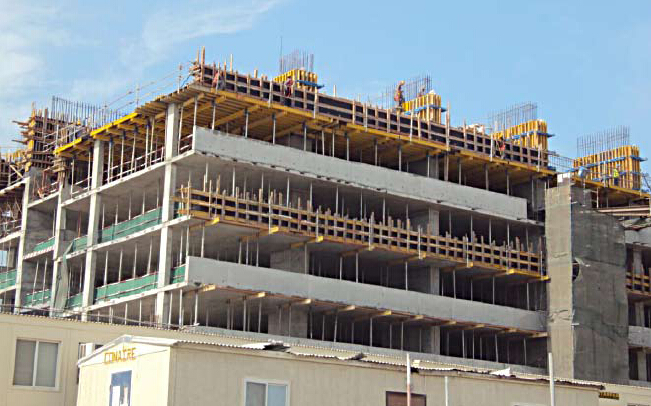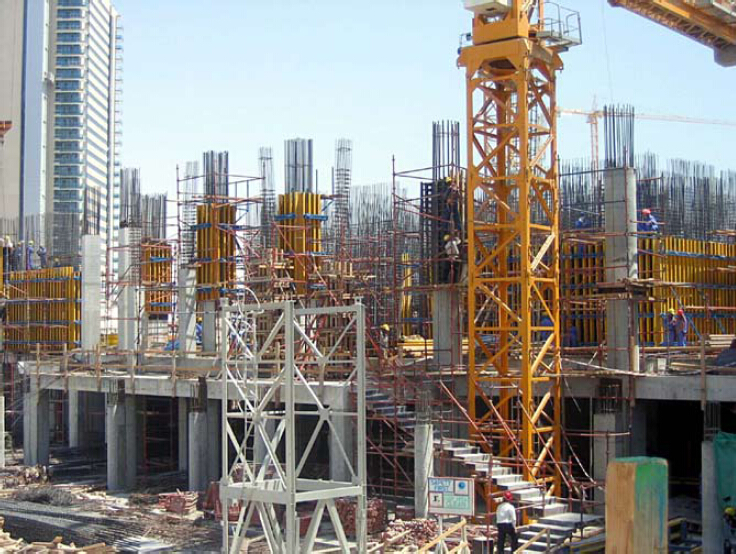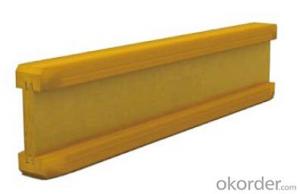Timber-Beam for formwork and scaffolding systems
- Loading Port:
- Tianjin
- Payment Terms:
- TT OR LC
- Min Order Qty:
- 50 m²
- Supply Capability:
- 1000 m²/month
OKorder Service Pledge
Quality Product, Order Online Tracking, Timely Delivery
OKorder Financial Service
Credit Rating, Credit Services, Credit Purchasing
You Might Also Like
Characteristics:
◆ Standardized production lines.
Supply capability: 3000m/day, Lmax = 6600mm.
◆ Finger jointing of the flange and web, the strength of timber beam is highly improved.
Max. shearing force failure load:40KN
◆ Well treated to prevent from water penetration or erosion, so the service life maximally extended.
Normally, CNBM timber beam H20 can be used for 4 to 5 years, the exact using time would depend on maintenance & storage.
◆ Robust caps at the end of the girders protect against damages.


- Q:What are the different locking mechanisms used in steel formwork?
- To ensure stability and integrity in concrete construction projects, various locking mechanisms are employed in steel formwork. These mechanisms are designed to securely fasten the formwork panels together, preventing any shifting or movement that could compromise the accuracy and quality of the final concrete structure. One widely used locking mechanism is the wedge clamp system. This system utilizes steel wedges, which are inserted between the formwork panels and tightened with a hammer or mallet. The wedges establish a robust connection between the panels, firmly anchoring them in place. Another popular locking mechanism is the pin and wedge system. This system involves the insertion of steel pins through holes in the formwork panels. Subsequently, steel wedges are driven into these holes, securing the pins firmly. This creates a stable and secure connection between the panels. Some steel formwork systems also employ a hook and loop mechanism. This entails the attachment of metal hooks to one panel and metal loops to the neighboring panel. The hooks and loops interlock, providing a strong connection between the panels. This mechanism is often favored for its convenience and efficiency, making it a popular choice for specific construction projects. Moreover, certain steel formwork systems combine different locking mechanisms. For instance, a system may incorporate both wedge clamps and pin and wedge systems to enhance stability and strength. Ultimately, the various locking mechanisms employed in steel formwork serve the purpose of ensuring the secure connection of formwork panels throughout the concrete pouring process. Each mechanism offers its own advantages and may be more suitable for specific project requirements.
- Q:How does steel formwork affect the overall construction material waste reduction?
- Steel formwork is a construction technique that involves using steel panels and frames to create temporary molds or structures into which concrete is poured. This method offers several advantages over traditional timber formwork, one of which is its positive impact on overall construction material waste reduction. Firstly, steel formwork is highly durable and can be reused multiple times, whereas timber formwork often needs to be replaced after a few uses due to wear and tear. This means that steel formwork significantly reduces the amount of material waste generated during the construction process, as there is minimal need for regular replacements. Additionally, steel formwork is more precise and accurate compared to timber formwork, resulting in less waste of concrete. The precise measurements and tight joints of steel formwork ensure that concrete is poured and set correctly, minimizing the need for additional material to fill gaps or rectify errors. This leads to a reduction in material waste, as less concrete is wasted during the construction process. Moreover, steel formwork is easily adaptable and adjustable to different shapes and sizes, allowing for efficient and flexible use on various construction projects. The versatility of steel formwork means that it can be reused for different structures or modified to suit changing requirements. This adaptability further reduces material waste, as the same formwork can be utilized for multiple projects or repurposed as needed. Furthermore, steel formwork is known for its high strength and load-bearing capacity, enabling it to withstand heavy concrete pressure without deformation or damage. This strength allows for taller and more complex structures to be constructed using steel formwork, reducing the need for additional materials such as support beams or columns. By eliminating the need for these extra materials, steel formwork contributes to a significant reduction in overall construction material waste. In summary, steel formwork positively impacts overall construction material waste reduction through its durability, precision, adaptability, and strength. By minimizing the need for regular replacements, reducing concrete waste, allowing for reuse and adaptability, and eliminating the need for additional materials, steel formwork plays a crucial role in promoting sustainable construction practices and reducing environmental impacts.
- Q:How does steel formwork impact the overall cost of a construction project?
- The overall cost of a construction project can be significantly influenced by steel formwork. While traditional timber formwork may have a lower initial cost, steel formwork offers various advantages that can lead to long-term cost savings. To begin with, steel formwork boasts greater durability and a longer lifespan compared to timber formwork. It can endure multiple uses without experiencing significant wear and tear, reducing the need for frequent replacements. This longevity eliminates the expenses associated with purchasing new formwork materials for each construction project, resulting in considerable savings in the long run. In addition, steel formwork provides superior strength and stability, allowing for the construction of larger and more complex designs. This enhanced structural integrity can reduce the necessity for additional support systems like props or scaffolding, which can increase overall project costs. Furthermore, steel formwork can be easily customized to fit various shapes and sizes, minimizing waste and optimizing material usage. Moreover, steel formwork enables faster assembly and dismantling times compared to timber formwork. Its modular nature allows for easy installation and removal, reducing labor costs and enhancing productivity. The shorter construction cycle facilitated by steel formwork can lead to significant time savings, enabling early project completion and reducing financing costs. Another cost-saving aspect of steel formwork is its reusability. It can be dismantled, cleaned, and reused in subsequent projects, minimizing the need for new formwork materials. This not only reduces material procurement costs but also decreases waste generation and environmental impact. However, it is important to note that the cost impact of steel formwork will vary depending on specific project requirements and regional factors such as material availability and labor costs. Therefore, conducting a detailed cost analysis considering all these factors is essential in determining the overall cost-effectiveness of steel formwork for a construction project.
- Q:What are the common durability issues with steel formwork systems?
- Steel formwork systems can encounter various durability issues. One major concern is corrosion, which arises when the steel comes into contact with moisture or harsh chemicals. If not addressed correctly, corrosion can weaken the formwork system's structural integrity and lead to premature failure. Another issue is wear and tear. Over time, repeated use of steel formwork systems can result in surface damage and deformation. This can create challenges in achieving precise and accurate concrete finishes, as well as pose safety risks for workers. Furthermore, mishandling and improper storage of steel formwork systems can cause bending or warping of the components. This can impact the overall stability and efficiency of the system, reducing its durability and reliability. Lastly, neglecting maintenance and failing to apply protective coatings can contribute to durability problems. Regular inspections, cleaning, and the application of protective coatings can prevent corrosion and prolong the lifespan of the steel formwork system. In conclusion, common durability issues with steel formwork systems encompass corrosion, wear and tear, mishandling and improper storage, and inadequate maintenance. Promptly addressing these concerns and implementing appropriate maintenance practices are crucial to ensure the longevity and effectiveness of the formwork system.
- Q:What are the common design considerations for steel formwork in cold climates?
- Some common design considerations for steel formwork in cold climates include ensuring that the formwork is insulated to prevent freezing of the concrete, using materials that can withstand low temperatures and extreme weather conditions, incorporating measures to prevent ice formation on the formwork surface, allowing for thermal expansion and contraction of the steel, and considering the impact of cold temperatures on curing time and strength development of the concrete. Additionally, proper maintenance and protection of the formwork during winter months is crucial to ensure its longevity and effectiveness.
- Q:Can steel formwork be used in areas with extreme temperature variations?
- Yes, steel formwork can be used in areas with extreme temperature variations. Steel is known for its durability and strength, which allows it to withstand various temperature conditions. However, it is important to consider potential expansion and contraction of the steel due to temperature changes, and take appropriate measures to prevent any negative effects on the formwork structure.
- Q:What are the common challenges faced during steel formwork transportation?
- During steel formwork transportation, there are several common challenges that may arise. One of the main challenges is the weight and size of the steel formwork. Steel formwork can be heavy and bulky, making it difficult to transport and handle. This can require special equipment and vehicles to safely transport the formwork to the desired location. Another challenge is the potential for damage or deformation during transportation. Steel formwork needs to be transported in a way that prevents any bending, twisting, or scratching. Improper handling or inadequate securing of the formwork can lead to damage, which may affect its performance and durability. The logistics of transportation can also be a challenge. Coordinating the delivery of steel formwork to construction sites can be complex, especially when multiple projects are ongoing simultaneously. Ensuring that the formwork arrives on time and in the correct quantities requires careful planning and coordination. Furthermore, the terrain and road conditions can pose challenges during transportation. If the construction site is located in a remote or difficult-to-access area, the transportation of steel formwork can be more challenging. Poor road conditions, narrow access roads, or steep inclines may require additional measures to ensure safe transportation. Lastly, safety considerations are paramount during steel formwork transportation. The weight and size of the formwork can pose risks to the personnel involved in loading, unloading, and securing the formwork. It is essential to follow proper safety protocols and provide appropriate training to the workers involved to minimize the risk of accidents or injuries. Overall, the common challenges faced during steel formwork transportation include the weight and size of the formwork, potential for damage or deformation, logistics of delivery, terrain and road conditions, and safety considerations. By addressing these challenges effectively, the transportation process can be executed smoothly, ensuring the timely and safe delivery of steel formwork to construction sites.
- Q:Can steel formwork be used for both residential and institutional projects?
- Yes, steel formwork can be used for both residential and institutional projects. Its strength and durability make it suitable for various construction projects, including residential buildings and institutional structures. Additionally, steel formwork offers flexibility and ease of use, allowing for efficient construction processes in both residential and institutional settings.
- Q:How does steel formwork affect the overall flexibility of the construction process?
- Steel formwork can significantly enhance the overall flexibility of the construction process. Due to its robustness and durability, steel formwork allows for the creation of complex and intricate designs, making it suitable for various construction projects. It enables the construction team to easily modify and adapt the formwork to meet specific project requirements, resulting in a more flexible construction process. Additionally, steel formwork can be easily dismantled and reused, providing cost-saving benefits and reducing construction waste.
- Q:How does steel formwork affect the overall construction site logistics?
- Steel formwork can have a significant impact on the overall construction site logistics. Firstly, steel formwork is known for its durability and strength, which allows for multiple reuses. This reduces the need for constant replacement and disposal of formwork materials, resulting in reduced waste generation and improved site cleanliness. Additionally, steel formwork is lightweight and easily adjustable, making it easier to handle and transport around the construction site. This enhances the efficiency of material handling and reduces the time required for formwork installation and removal. Moreover, the lightweight nature of steel formwork reduces the load on the structure, resulting in reduced transportation costs and improved safety during construction. Steel formwork also offers high dimensional accuracy, ensuring precise and consistent shapes for concrete elements. This precision can help streamline the construction process, as it reduces the need for excessive adjustments and rework. This leads to improved time management and increased productivity on the construction site. Furthermore, steel formwork provides a smooth and even finish to concrete structures, resulting in better-quality finishes. This can eliminate the need for additional surface treatments and reduce the time and effort required for finishing work. Overall, steel formwork contributes to improved construction site logistics by reducing waste, enhancing material handling efficiency, improving construction speed, and ensuring high-quality finishes. Its durability, lightweight nature, and dimensional accuracy make it a valuable asset in optimizing construction processes and achieving project timelines more effectively.
1. Manufacturer Overview |
|
|---|---|
| Location | |
| Year Established | |
| Annual Output Value | |
| Main Markets | |
| Company Certifications | |
2. Manufacturer Certificates |
|
|---|---|
| a) Certification Name | |
| Range | |
| Reference | |
| Validity Period | |
3. Manufacturer Capability |
|
|---|---|
| a)Trade Capacity | |
| Nearest Port | |
| Export Percentage | |
| No.of Employees in Trade Department | |
| Language Spoken: | |
| b)Factory Information | |
| Factory Size: | |
| No. of Production Lines | |
| Contract Manufacturing | |
| Product Price Range | |
Send your message to us
Timber-Beam for formwork and scaffolding systems
- Loading Port:
- Tianjin
- Payment Terms:
- TT OR LC
- Min Order Qty:
- 50 m²
- Supply Capability:
- 1000 m²/month
OKorder Service Pledge
Quality Product, Order Online Tracking, Timely Delivery
OKorder Financial Service
Credit Rating, Credit Services, Credit Purchasing
Similar products
New products
Hot products
Hot Searches
Related keywords

























